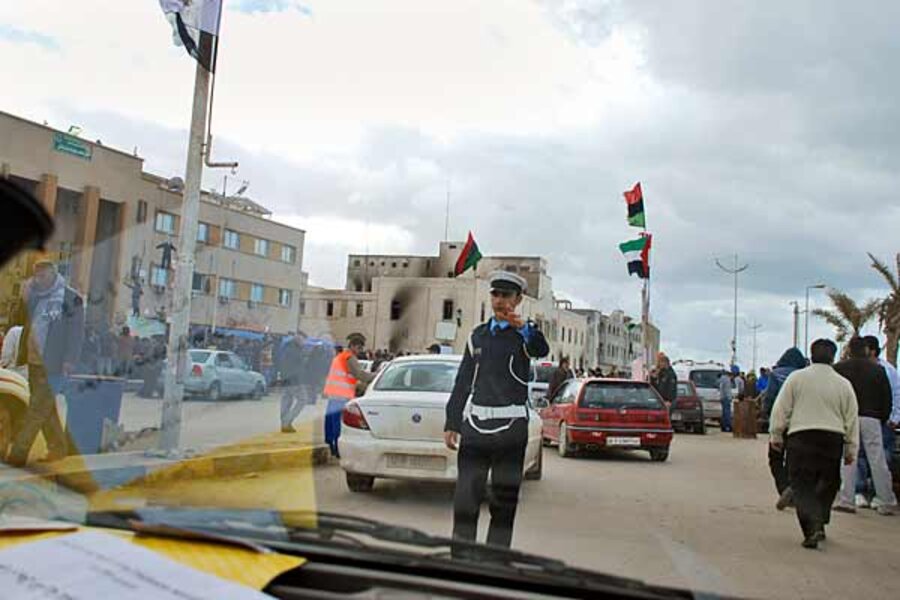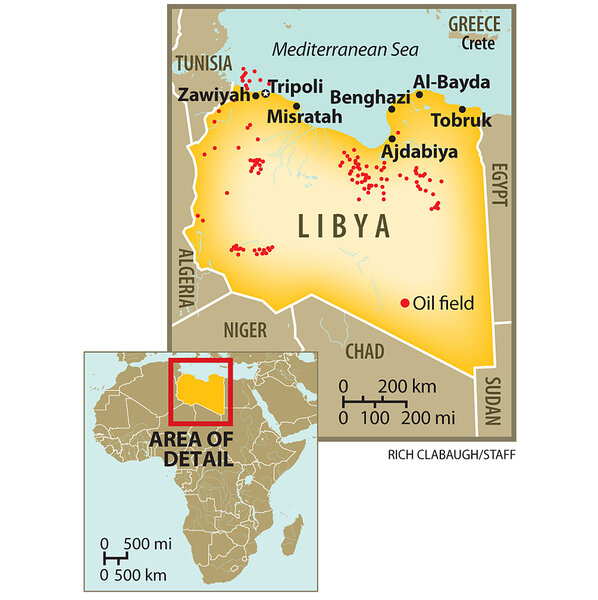Why Qaddafi is losing parts of Libya
| Washington
Libya seems to be falling apart. The regime of Col. Muammar Qaddafi remains in control of the capital of Tripoli, but much of the eastern part of the country, including the city of Benghazi, has fallen to a fast-moving rebellion. On Wednesday opposition leaders said they had seized control of the western city of Misratah, as well.
The suddenness of this collapse underscores how decades of Colonel Qaddafi’s misrule have undermined support for his regime. But it may also reflect the fact that Libya is composed of three distinct areas that in essence were stapled together in the 20th century to make a modern nation.
Despite the ancient history of some of its cities, Libya is not Egypt – a country with a proud past that speaks to virtually all its people. It is a new political entity that is still developing a national consciousness, according to a US Library of Congress profile.
“Until Libya achieved independence in 1951, its history was essentially that of tribes, regions, and cities, and of the empires of which it was a part,” concludes the study.
Geography's role in Libyan history
Geography is the dominant factor in Libya’s political history. Its regions are separated by vast deserts that kept them isolated from one another until only a few years before Qaddafi seized power in a 1969 coup.
Tripolitania, the region in Libya’s northwest, is home to Tripoli and much of what passes for Qaddafi’s regime infrastructure. For centuries it was oriented to the Maghreb, the western Islamic world of northern Africa, which also includes Morocco and Algeria. Tripoli, a port, was a haven for pirates and slave traders for centuries.
The northeast region of Cyrenaica, by contrast, historically has been oriented toward neighboring Egypt. With the exception of some its coastal towns, this area for centuries remained largely beyond the writ of regimes based to the west.
“Many Cyrenaicans demonstrated a determination to retain their regional autonomy even after Libyan independence and unification,” notes the Library of Congress.
This area includes Benghazi, which quickly slipped from Qaddafi’s grip once the revolt began to take hold.
Libya’s third region is the Fezzan, to the southwest. Isolated from the cities of the coast, it traditionally looked for authority to the tribes that controlled the oases astride desert trade routes. It long maintained ties with sub-Saharan Africa, as well.
Over the centuries, the area that is Libya today was controlled by a string of empires, from the Phoenicians and the Greeks to the Ottoman Turks and the Italians.
The scene of intense desert warfare in World War II, Libya was occupied by British and French troops after the capitulation of Axis power Italy. Per a vote of the UN General Assembly, it gained independence as a constitutional monarchy in December 1951.
First phase of rule
Qaddafi seized power in a bloodless military coup in 1969, first in Benghazi and then Tripoli and the rest of the country. He and his fellow revolutionary council members were “pan-Arabist and socialist ideologues from rural and somewhat marginalized communities,” says a Congressional Research Service history of US-Libyan relations.
The US did not initially oppose the coup as Qaddafi and his fellow revolutionaries presented themselves as anti-Soviet reformers. Initially they made an attempt to create a diversified national economy fueled by oil revenues.
“The [Qaddafi] regime made the first real attempt to unify Libya’s diverse peoples and to create a distinct Libyan state and identity,” concludes the Library of Congress.
Decades of Qaddafi’s increasingly quixotic rule undid many of his attempts at forging a Libyan consciousness, however. Given the unifying effects of oil money, it remains likely that Libya still will hang together as a unitary entity, no matter what happens in days to come.
But if Qaddafi loses his grip on power – something that now seems likely to happen – it is also possible that Libya will follow the example, not of Egypt or Tunisia, but of the former nation of Yugoslavia, a modern conglomerate state that broke into Balkan regions following the death of strongman Josip Tito.






